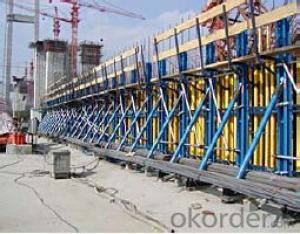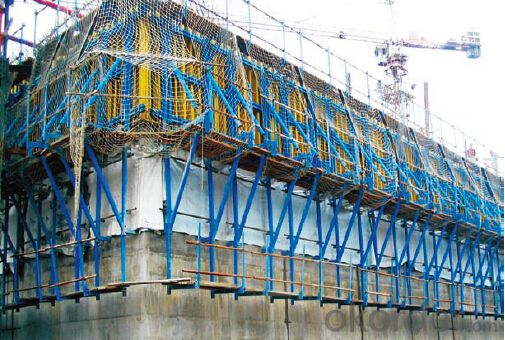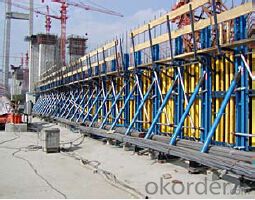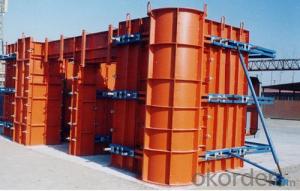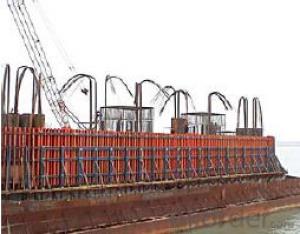Single-side climbing bracket SCB40 for formwork and scaffolding systems
- Loading Port:
- Tianjin
- Payment Terms:
- TT OR LC
- Min Order Qty:
- 50 m²
- Supply Capability:
- 1000 m²/month
OKorder Service Pledge
OKorder Financial Service
You Might Also Like
Single-side Climbing Bracket SCB180:
With CNBM SCB 180 climbing systems, the loads from the fresh concrete pressure are
transferred through the brackets by means of V-strongbacks and compression braces into the
scaffold anchors.
Typical applications for the SCB 180 are dams, locks, cooling towers, pier heads, tunnels, and
bank vaults.
The formwork is simply tilted backwards when striking takes place. The 1.80 m wide bracket
requires only a minimum of space.
Characteristics:
◆ Economical and safe anchoring
The M30/D20 climbing cones have been designed especially for single-sided concreting using
SCB180 in dam construction, and to allow the transfer of high tensile and shear forces into the still
fresh, unreinforced concrete. Without wall-through tie-rods, finished concrete is perfect.
◆ Stable and cost-effective for high loads
generous bracket spacings allow large-area formwork units with optimal utilization of the bearing
capacity. This leads to extremely economical solutions.
◆ Simple and flexible planning
With SCB180 single-sided climbing formwork, circular structures can also be concreted without
undergoing any large planning process. Even use on inclined walls is feasible without any special
measures because additional concrete loads or lifting forces can be safely transferred into the
structure.
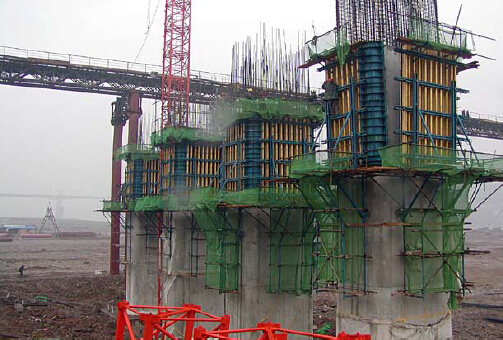
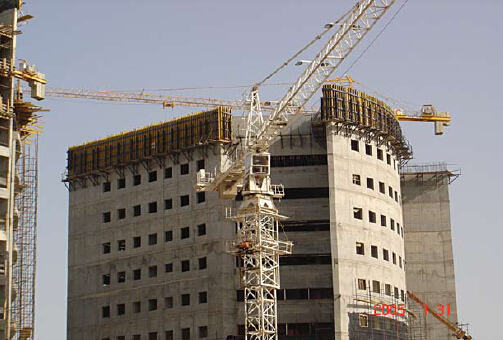
- Q: How does steel formwork perform in seismic zones?
- Due to its high strength and durability, steel formwork is an excellent choice for seismic zones. The robustness of steel enables it to withstand the intense shaking and vibrations caused by earthquakes, as it has outstanding load-bearing capacity and resistance to bending and shearing forces. During an earthquake, seismic zones experience significant ground movement, which exerts immense pressure on the formwork system. However, steel formwork remains rigid and strong, preventing any significant deformation or damage. This ensures the stability and integrity of the structure both during and after the seismic event. Furthermore, steel formwork provides flexibility in design and construction, allowing for reinforced concrete structures that can better handle seismic loads. Additional reinforcement elements, such as steel bars and mesh, can be incorporated with the use of steel formwork, enhancing overall strength and ductility. This helps dissipate the energy generated by seismic forces and reduces the risk of structural failure. In addition to its performance, steel formwork is also cost-effective and sustainable in seismic zones. It can be easily dismantled and reassembled, making it reusable and facilitating quick repair and reconstruction in the event of earthquake damage. This minimizes downtime and ensures the safety of occupants. In conclusion, steel formwork is a reliable and resilient choice for construction in seismic zones. Its strength, durability, and flexibility make it well-suited to withstand the forces generated by earthquakes, ensuring the safety and stability of structures in these high-risk areas.
- Q: How does steel formwork handle concrete pouring and consolidation?
- Steel formwork is a highly durable and rigid material that is capable of handling the pressure and weight of concrete during pouring and consolidation. Its strong structure ensures that the formwork remains stable and does not deform under the weight of the concrete. The smooth surface of steel formwork also allows for easy and efficient pouring and spreading of concrete, ensuring a consistent and even distribution. Additionally, steel formwork's ability to withstand the pressure exerted during consolidation prevents any deformation or movement, resulting in a solid and well-structured concrete structure.
- Q: How does steel formwork handle concrete surface blemishes?
- Steel formwork is a popular choice for construction projects due to its durability and strength. When it comes to handling concrete surface blemishes, steel formwork offers several advantages. Firstly, the smooth and rigid surface of steel formwork helps minimize the occurrence of surface blemishes on the concrete. Unlike other formwork materials such as timber, steel does not warp or deform easily, ensuring a consistent and even surface for the concrete to be poured onto. This reduces the chances of surface imperfections like air pockets, formwork marks, or uneven textures. Moreover, steel formwork allows for precise control over the concrete pouring process. The steel panels are manufactured with high precision, ensuring accurate dimensions and alignment. This precision, coupled with the tight joints and connections between the panels, minimizes the likelihood of concrete seepage or leakage, which can lead to surface blemishes such as honeycombing or efflorescence. Additionally, steel formwork can be easily cleaned and maintained, which further contributes to preventing or handling concrete surface blemishes. The smooth surface of steel allows for easy removal of any excess concrete or debris that might accumulate during the pouring process. This prevents the formation of unwanted blemishes and preserves the quality of the concrete surface. In cases where concrete surface blemishes do occur, steel formwork offers the advantage of being reusable. Unlike other formwork materials that may need to be discarded after a single use, steel formwork can be easily cleaned, repaired, and reused for multiple projects. This allows for more control over the quality of the formwork, reducing the risk of surface blemishes in subsequent concrete pours. In conclusion, steel formwork handles concrete surface blemishes effectively by providing a smooth and rigid surface, precise control over the pouring process, easy maintenance and cleaning, and reusability. These features contribute to achieving a high-quality concrete surface with minimal blemishes, ensuring a visually appealing and structurally sound end result.
- Q: How does steel formwork impact the overall project management?
- Steel formwork can have a significant impact on the overall project management in various ways. First and foremost, steel formwork is known for its durability and longevity, which means it can be reused multiple times throughout the project. This reduces the need for frequent replacements and repairs, saving both time and money. Moreover, steel formwork provides a high level of accuracy and precision, ensuring that the concrete structures are built according to the specified dimensions and specifications. This not only enhances the quality of the project but also minimizes the chances of rework or corrective measures, thereby saving time and resources. Additionally, steel formwork offers greater flexibility and versatility compared to traditional wooden formwork. It can be easily adjusted and modified to accommodate changes in design or unforeseen circumstances during the construction process. This adaptability enables project managers to make on-site adjustments quickly and efficiently, keeping the project on track and minimizing delays. Furthermore, steel formwork is known for its faster installation and dismantling process. This allows for faster construction cycles, enabling project managers to meet tight deadlines and complete the project within the scheduled timeframe. The faster turnaround time also improves project efficiency and reduces overall project costs. Lastly, steel formwork is considered a safer option compared to other formwork materials. It provides a stable and secure platform for workers, minimizing the risk of accidents and injuries. By prioritizing worker safety, project managers can maintain a productive and efficient work environment. In conclusion, steel formwork has a positive impact on overall project management by enhancing durability, accuracy, flexibility, speed, and safety. Utilizing steel formwork can lead to improved project outcomes, reduced costs, and enhanced efficiency, ultimately contributing to the successful completion of the project.
- Q: What are the common challenges faced when using steel formwork?
- There are several common challenges faced when using steel formwork in construction projects. One of the main challenges is the cost. Steel formwork can be more expensive compared to other types of formwork materials such as wood or plastic. This can make it less accessible for smaller construction projects or those with tight budgets. Another challenge is the weight of steel formwork. Steel is a heavy material, which can make it difficult to handle and transport on the construction site. It requires specialized equipment and manpower to move and assemble the formwork, which can add to the overall project costs. Steel formwork also requires skilled labor for its installation and dismantling. The assembly process can be complex, and if not done properly, it can lead to inaccuracies in the concrete structure. This requires experienced workers who are familiar with steel formwork systems and have the necessary expertise to ensure the formwork is properly aligned and secured. Additionally, steel formwork requires regular maintenance and cleaning to ensure its longevity. Steel is susceptible to rust and corrosion, especially when exposed to moisture or chemicals. This means that the formwork needs to be regularly inspected, repaired, and protected to prevent any degradation or structural issues. Lastly, steel formwork is not as versatile as other types of formwork. It is typically used for repetitive and standardized construction projects, where the same formwork configuration is required repeatedly. Customization and flexibility can be limited with steel formwork, which can be a challenge for projects that require unique or intricate designs. Despite these challenges, steel formwork also offers several advantages such as its durability, strength, and reusability. It provides a sturdy and stable structure for pouring concrete, allowing for faster construction times and improved quality. However, it is important to carefully consider the specific requirements and constraints of a construction project before deciding to use steel formwork.
- Q: How does steel formwork affect the overall durability of a construction project?
- The overall durability of a construction project can be significantly impacted by steel formwork. One of the main advantages of using steel formwork is its strength and durability. Steel possesses high tensile strength, allowing it to withstand heavy loads and resist deformation. This strength is essential in maintaining the formwork's shape and integrity during construction. Furthermore, steel formwork is highly resistant to wear and tear, making it suitable for multiple uses and reuses. Unlike wood and other materials, steel does not easily degrade or deteriorate, ensuring the formwork remains in good condition for extended periods. This durability is particularly crucial in large-scale construction projects that require repetitive formwork installations. Additionally, steel formwork offers excellent dimensional stability. It does not warp or shrink under varying weather conditions, ensuring the accuracy and precision of the concrete structure being formed. This is essential to meet the required specifications and standards for the final construction project. The durability of steel formwork also contributes to the overall safety of the construction project. Its strength and stability prevent potential formwork failures that could lead to accidents or structural damages during the concrete pouring process. By providing a secure and reliable support system, steel formwork enhances worker safety and the long-term structural integrity of the building. Moreover, the durability of steel formwork translates into cost-effectiveness over the project's lifespan. The ability to reuse steel formwork reduces the need for constant replacement, saving time and money on material expenses. Additionally, the reduced maintenance required for steel formwork lowers ongoing maintenance costs, making it a cost-effective choice for construction projects. In conclusion, steel formwork significantly contributes to the overall durability of a construction project. Its strength, resistance to wear and tear, dimensional stability, and safety features ensure the formwork remains intact throughout the construction process. This durability not only enhances the structural integrity of the building but also provides cost-effectiveness and peace of mind for project stakeholders.
- Q: Can steel formwork be used in curved or irregular structures?
- Yes, steel formwork can be used in curved or irregular structures. Its flexible nature allows it to be easily shaped and adjusted to fit the desired curves and angles of the structure. Additionally, steel formwork offers high strength and durability, making it suitable for various construction projects, including those with unconventional shapes.
- Q: What are the common safety certifications for steel formwork systems?
- Steel formwork systems can obtain various safety certifications to guarantee the highest safety and quality standards. Some of the most well-known certifications are as follows: 1. ISO 9001: This certification ensures that the manufacturer of the steel formwork system adheres to an internationally recognized quality management system. It focuses on meeting customer satisfaction, continuously improving processes, and complying with regulatory requirements. 2. OHSAS 18001: Specifically aimed at occupational health and safety management systems, this certification demonstrates that the manufacturer has implemented effective safety policies, procedures, and controls to prevent work-related injuries and illnesses. 3. CE Marking: This certification is compulsory for steel formwork systems sold in the European Union (EU) and verifies that the product meets essential health, safety, and environmental protection requirements set by EU legislation. 4. ANSI/ASSE A10.9: Developed by the American National Standards Institute (ANSI), this standard provides guidelines for the design, use, and maintenance of formwork systems, including steel formwork. Complying with this standard ensures the system's safety and suitability for construction projects. 5. UL Certification: Underwriters Laboratories (UL), a globally recognized safety certification organization, grants UL Certification to steel formwork systems that have undergone rigorous testing and meet specific safety standards. It is important to note that the required safety certifications may vary depending on the country and region. Therefore, it is recommended to consult local regulations and standards applicable to the construction project before selecting a steel formwork system.
- Q: Can steel formwork be used for projects with aggressive concrete mixes?
- Yes, steel formwork can be used for projects with aggressive concrete mixes. Steel formwork is known for its strength, durability, and resistance to various environmental factors. Aggressive concrete mixes typically contain higher amounts of chemicals such as chlorides, sulfates, or alkalis, which can be corrosive to some materials. However, steel formwork is usually resistant to these aggressive chemical attacks and can withstand the harsh conditions associated with aggressive concrete mixes. It is important to ensure that the steel formwork used is properly coated or treated to enhance its resistance to corrosion and chemical attacks. Regular maintenance and inspection of the formwork are also necessary to identify and address any signs of deterioration or damage. Overall, steel formwork can be a suitable choice for projects with aggressive concrete mixes due to its strength and resistance to chemical attacks.
- Q: What is the 86 series steel formwork
- The utility model is used for pouring concrete, and the length is 300, 450, 600, 900, 1200, 1500, width of 200, and 300.
Send your message to us
Single-side climbing bracket SCB40 for formwork and scaffolding systems
- Loading Port:
- Tianjin
- Payment Terms:
- TT OR LC
- Min Order Qty:
- 50 m²
- Supply Capability:
- 1000 m²/month
OKorder Service Pledge
OKorder Financial Service
Similar products
Hot products
Hot Searches

